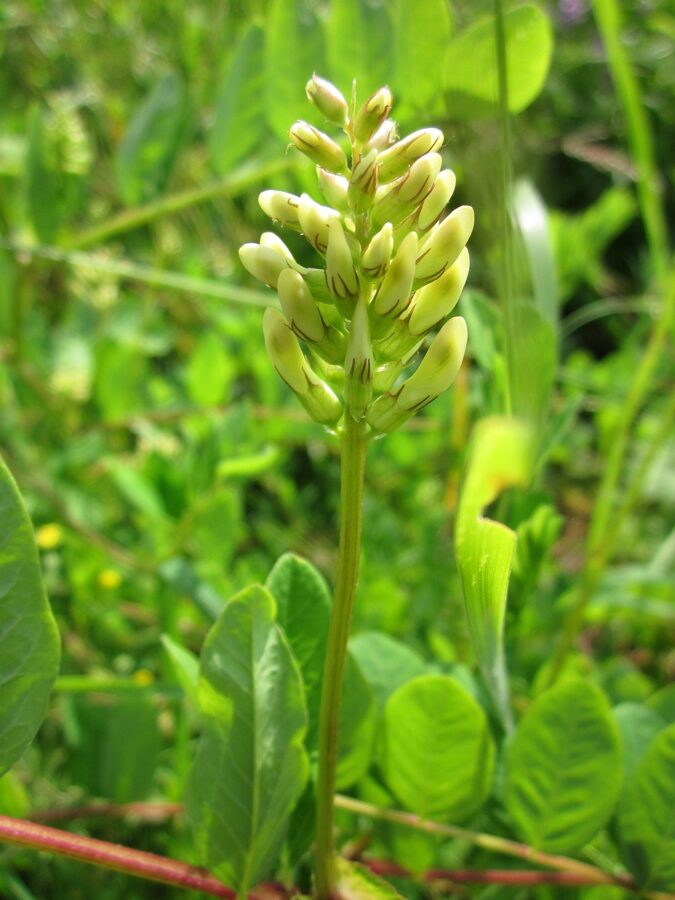 |  |  |  |  |
 |
Astragalus glycyphyllos (Wild Liquorice) is a perennial plant reaching up to 90 cm in height, though its stems may be longer as they sprawl along the ground. Belonging to the legume family (Fabaceae), the plant tends to branch out and cling to nearby objects, often forming dense thickets.
The leaves are imparipinnate with 4–12 pairs of leaflets. They are ovate in shape, yellow-green in color, and slightly translucent. The flowers are greenish-yellow and arranged in elongate-ovoid racemes. The floral formula of Astragalus glycyphyllos is: ↑K(5)C1+2+2A(10)G1.
The fruits are pods that grow upright in clusters. They are closely spaced and about 4 cm long. The plant typically blooms during the summer months, from June to August, with fruit maturing in August and September.
Astragalus glycyphyllos is commonly found in forests, forest edges, and river floodplains. It prefers moderately moist, slightly acidic soils and thrives in shaded areas with medium humidity. The stems interweave to form thick, almost impenetrable growth.
Harvesting of Raw Materials
Astragalus is harvested during its flowering period in June and July, and it is important to complete the process before the pods begin to form. Leaves should be free of disease — for example, powdery mildew (a white coating) makes them unsuitable for medicinal use.
Typically, the aerial parts of the plant are cut at a height of 5–7 cm above the ground. Some stems with flowers should be left for reproduction, as they will develop into pods. Astragalus reproduces by seed, and harvesting all flowers may result in the plant disappearing from that area. It is not recommended to harvest Astragalus from the same location every year; usually, it is harvested once every 3–4 years.
The cut stems and flowers are dried under cover in a well-ventilated area. In dry weather, 5–7 days are usually sufficient for drying. Turning the material periodically helps it dry evenly. If needed, the dried plant is chopped and used in the production of various food supplements.
In China, the root of Astragalus is commonly used. It is harvested in the autumn, then dried and crushed. In some cases, it is also used as a spice.
Chemical Composition
Astragalus glycyphyllos contains various organic acids, including ascorbic acid (vitamin C), which stimulates the human immune system. It also includes B-group vitamins and a high concentration of vitamin C. Polysaccharides contribute to faster recovery and help activate the body’s natural defense mechanisms, while flavonoids may slow the development of cancerous growths. In addition, the leaves contain essential oils, rutin, tannins, and alkaloids.
Pharmacological Properties
Astragalus glycyphyllos has been scientifically proven to strengthen the immune system in the fight against various diseases, including cancer and heart conditions. It partially restores immune cell function. Some studies have shown that it may reduce the duration of the common cold. Astragalus may stimulate the body to produce interferon — a substance used by the immune system to defend against viral infections.
In 2006, research into the effects of Astragalus on lung cancer provided evidence that this herb could enhance the effectiveness of platinum-based chemotherapy drugs such as cisplatin. Although research is ongoing, more and more scientists acknowledge that the plant may help patients better tolerate the procedures associated with cancer treatment.
Astragalus also promotes burn healing, offers protection against cardiovascular diseases, and is used to combat colds and general fatigue. In traditional medicine, it is used to stimulate the spleen, liver, lungs, circulation, and the urinary system. It also helps in the treatment of arthritis, asthma, and nervous disorders. Additionally, there is evidence that it may help lower blood glucose levels and reduce blood pressure.
Use in Traditional Medicine
In various regions of Russia and neighboring countries, Astragalus glycyphyllos is traditionally used to treat a wide range of ailments. In the Volga region, it is believed that a decoction of Astragalus helps with nervous disorders and epilepsy. Women drink it to enhance their beauty and to support fertility.
In the southern parts of the country, Astragalus is used as a remedy for impotence. It is infused along with senna, hawthorn, and celery, and consumed as part of a treatment course two to three times a year. The same infusion is also used to treat venereal diseases.
In the Caucasus, Astragalus is included in herbal blends used to prepare decoctions for kidney ailments. Its diuretic effect helps expel kidney stones and sand, alleviating acute pain.
In Belarus, Astragalus is used as an expectorant for colds and heavy nasal discharge. However, its main value lies in its immune-boosting properties. It activates the body's natural healing processes, which is why its therapeutic scope is so broad.
In folk medicine, Astragalus is also used to treat sexually transmitted infections, leucorrhea, and uterine prolapse. During childbirth, a decoction of the herb is given to promote placental separation and to accelerate labor.
Among northern peoples, Astragalus is used to treat dysentery, rheumatism, dermatitis, and stomach cramps. Decoctions are also prepared as nasal drops to ease breathing and reduce inflammation of the nasal mucosa.
